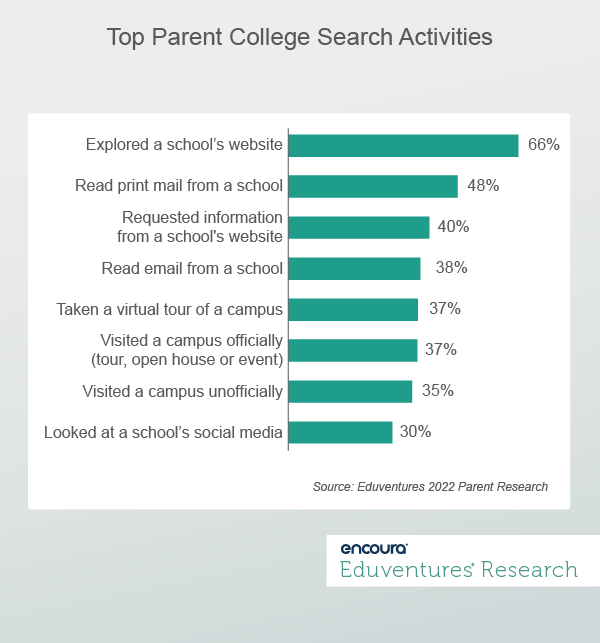June 14-16, 2023
Boston, MA
At the end of a recent presentation of Eduventures Parent Research, I asked an audience of enrollment professionals if they thought they had good parent landing pages and requests for information (RFIs). Two hands went up in a room of 30. Humbly, the rest admitted they were striving to do better.
Despite plenty of data showing that parents and students are in it together, parents often rely on college search information designed for a student audience. How can we do better?
In March, we wrote about the key aspects of developing a parent communications plan. Today we will focus on specific actions you should take to jumpstart your parent communications strategy by understanding the parent role in college search.
To begin, here are some telling stats from our 2022 Prospective Parent Research™:
Eduventures Principal Analyst at Encoura Contact Creating a successful outreach strategy for parents/guardians requires an understanding of their involvement in their student’s college search process. Eduventures’ Prospective Parent Research™ provides insight into the preferences and expectations of parents/guardians of college-bound high schoolers, equipping institutions to shape their communications to best address what’s on the minds of these parents/guardians.
- 97% of parents are involved with their students in college searches; 41% are at least 50-50 partners.
- 59% of parents influence the decision about which schools their children will apply to.
- 46% of parents begin thinking about the colleges their children might apply to by ninth grade.

Reaching Parents through Website RFI’s
| Explored Website | Requested Information | Potential Reach* | |
|---|---|---|---|
| Child is First-Generation | 58% | 37% | 22% |
| Low Income | 48% | 38% | 18% |
| Underrepresented Minority | 58% | 45% | 26% |
| Less than Bachelor’s Degree | 58% | 39% | 22% |
| All Parents | 66% | 40% | 26% |
Figure 2.Source: Eduventures 2022 Parent Research *Potential Reach = Percentage Explored Website x Percentage Requested Information
On average, you may be able to reach slightly more than a quarter (26%) of parents if you can provide a parent-focused RFI on your website—that’s a good start for parent communications. Parents in demographic groups with historically low access to higher education use websites at lower rates than the total population average. For example, on the low end, about one half (48%) of parents from low-income households explored websites to learn about colleges in comparison to two-thirds of the total population. Thirty-eight percent of low-income parents had requested information from schools. Thus, the potential reach into the low-income parent segment is 18%. Parents who are in underrepresented minority groups also explored websites to a lesser extent (58%) than the total population. But these parents were more engaged in requesting information (45%) than the total population average (40%). The potential reach into the underrepresented minority segment is a solid 26%. In any case, the entry point to creating an effective parent communication strategy is to develop the synergy of strong parent web pages with clear parent RFIs. To be clear, a student RFI with an option to send info to a parent isn’t good enough— it requires the student to be the gatekeeper. The gold standard is to allow parents to speak for themselves as equal participants in college search. Here are three examples of institutions that do a good job of providing parent pages and parent RFIs: Sewanee, the University of the South; Duke University; and University of Missouri.The Bottom Line
While most colleges give students primacy as the buyer they must appeal to, parents should have equal standing as buyers of undergraduate education. Follow these steps to jumpstart your parent strategy:- Develop your institutional and admissions website parent focused resources.
- Assess which student-focused content you can repurpose or reposition to appeal to parents.
- Give parents the opportunity to identify themselves with a parent specific RFI.
- Develop early parent campaigns that provide essential support for the parents in helping their children understand majors and potential career paths.
- Communicate clearly about career outcomes and marketability of degrees.
Learn more about our team of expert research analysts here.
Eduventures Principal Analyst at Encoura Contact Creating a successful outreach strategy for parents/guardians requires an understanding of their involvement in their student’s college search process. Eduventures’ Prospective Parent Research™ provides insight into the preferences and expectations of parents/guardians of college-bound high schoolers, equipping institutions to shape their communications to best address what’s on the minds of these parents/guardians.
- Parent/Guardian mindsets: Do parents/guardians see the same pathways through college as students do?
- Parents’/Guardians’ roles in college search: How hands-off or hands-on are parents/guardians in preferences and choices about schools, careers, majors, etc.?
- College costs: Are the price sensitivities of parents/guardians and students aligned?
- Value perception of college. Do parents/guardians see value in a college education? What do they want their children to derive from their college educations?
- Nationwide benchmarks for yield outcomes
- Changes in the decision-making behaviors of incoming freshmen that impact recruiting
- Gaps between how your institution was perceived and your actual institution identity
- Regional and national competitive shifts in the wake of the post-COVID-19 environment
- Competitiveness of your updated financial aid model

